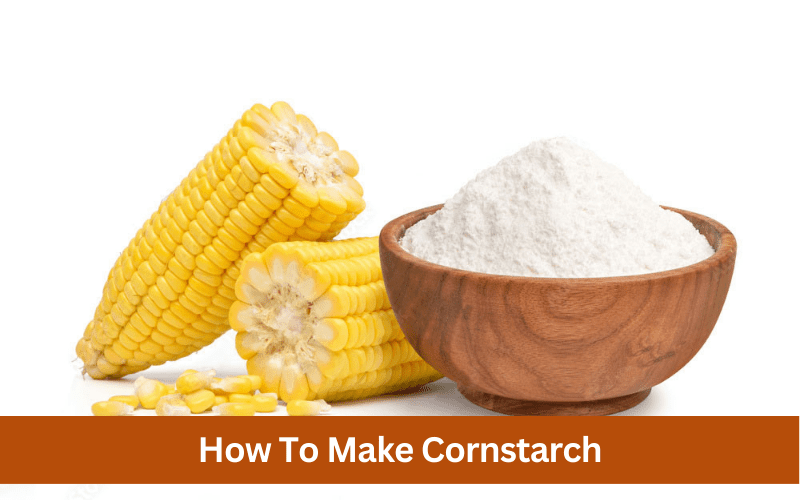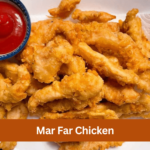As someone who loves cooking and experimenting with different ingredients, I’ve always been fascinated by the process of making my own ingredients from scratch. One such ingredient that I recently learned how to make is cornstarch. Cornstarch is a fine, powdery substance that is commonly used as a thickening agent in various recipes. It’s a staple ingredient in many households and is often used in everything from sauces and gravies to desserts and baked goods.
Making cornstarch from scratch may seem like a daunting task, but it’s actually quite simple and straightforward. Not only is it a fun DIY project, but it also has several benefits. For one, making cornstarch at home ensures that you have a fresh and natural product free of any additives or preservatives. It’s also a great way to reduce waste, as you can use the leftover corn pulp for other recipes or compost it.
In this blog post, I’ll be sharing my personal experience and step-by-step guide on how to make cornstarch at home. From choosing the right corn to drying and storing the finished product, I’ll walk you through the entire process. So whether you’re a seasoned cook or a beginner looking to try something new, let’s get started and learn how to make cornstarch together!
What is cornstarch?
Cornstarch is a fine, powdery substance that is derived from the endosperm of the corn kernel. It is made by grinding the corn into a fine powder and then extracting the starch from it. Cornstarch is often used as a thickening agent in various recipes due to its ability to absorb and hold onto liquids.
Cornstarch is a versatile ingredient that is commonly used in cooking and baking. It is often used as a thickening agent in sauces, gravies, soups, and stews. It can also be used to thicken fruit fillings in pies, puddings, and custards. Additionally, cornstarch is often used as a coating for fried foods to help give them a crispy texture.
Aside from its use in the kitchen, cornstarch has other practical uses as well. It can be used as a substitute for talcum powder, as a dry shampoo for pets, and even as a remedy for diaper rash. Cornstarch is also used in the manufacturing of various products such as paper, textiles, and plastics.
History of cornstarch
Cornstarch has a rich history that dates back thousands of years. Starch has been used in both cooking and non-cooking applications throughout history, with evidence of its use dating back to predynastic Egypt.
However, it wasn’t until the 1840s that cornstarch as we know it today came to prominence. This was thanks to Thomas Kingsford, who isolated cornstarch from corn kernels using a process for extracting wheat starch. Kingsford’s method involved soaking the kernels in an alkaline solution, then grinding them. This marked the beginning of what would become modern wet milling.
Initially, Kingsford intended the product for use as laundry starch. The practice of starching clothes added a soft but crisp texture to fabrics and improved their resistance to being soiled. However, in the 1850s, cornstarch began to be used as a food additive. It quickly became popular due to its ability to thicken sauces, gravies, and other dishes.
In the following decades, the use of cornstarch in food continued to grow. It was used in a wide range of applications, from thickening soups and stews to making custards and puddings. The food industry also began using cornstarch as a coating for fried foods, helping to give them a crispy texture.
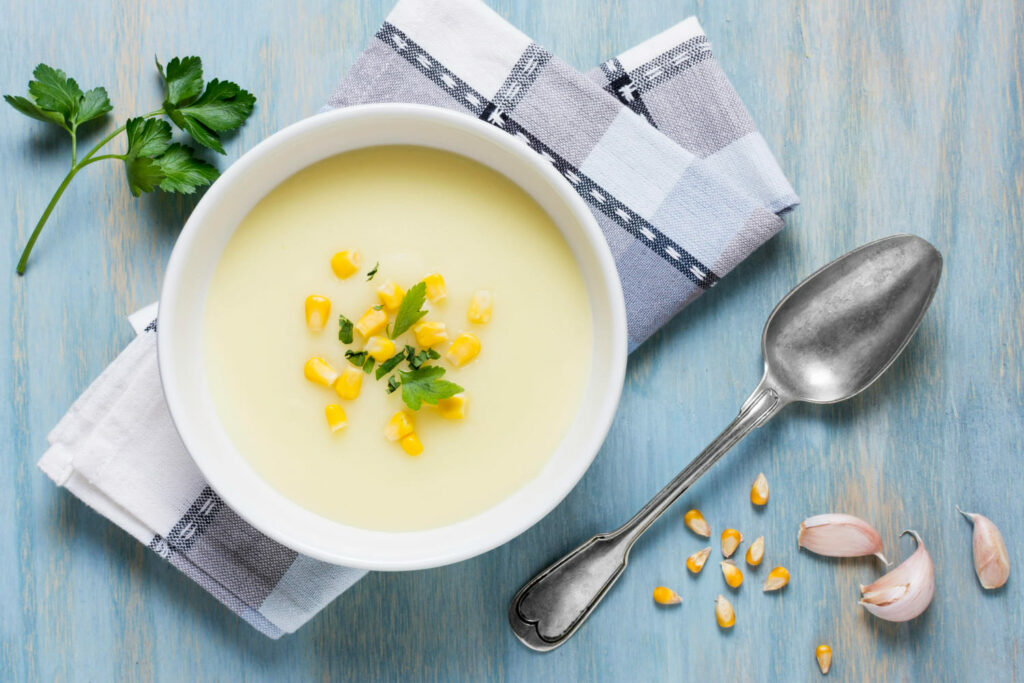
Today, cornstarch is a staple ingredient in many households and is used in a variety of cooking and baking applications. Its versatility and ability to thicken and stabilize foods make it a valuable ingredient in both home kitchens and the food industry.
Ingredients needed for making cornstarch
To make cornstarch at home, you’ll need a few essential materials. The first and most obvious one is corn. You can use any type of corn, but I recommend using fresh, organic corn if possible. You’ll also need water to help extract the starch from the corn.
In addition to corn and water, you’ll need several bowls to hold the corn and water mixture during the process. You’ll also need a blender or food processor to grind the corn into a fine paste. A wooden spoon or spatula will come in handy to help you stir the mixture and ensure that the corn is fully ground.
To strain the corn and separate the starch from the liquid, you’ll need a cheesecloth or fine-mesh strainer. You’ll also need baking sheets or trays to dry the cornstarch after it’s been strained. Clean towels will also be necessary to help absorb excess moisture during the drying process.
Finally, you’ll need airtight containers to store the finished cornstarch. It’s important to store it in a cool, dry place to prevent any moisture from getting in and spoiling the product.
Now that you have all the necessary materials, let’s move on to the step-by-step guide on how to make cornstarch at home.
Step-by-step how to make cornstarch?
Now, let’s dive into the step-by-step guide on how to make cornstarch at home:
Preparation of the Corn
Cleaning and Sorting: Begin by removing the husks and silks from the corn and washing it thoroughly. Sort the corn to ensure that you only use the freshest and healthiest kernels.
Soaking and Rinsing: Soak the corn in water for at least 4 hours or overnight. Drain the water and rinse the corn several times until the water runs clear.
Grinding the Corn
Using a Blender or Food Processor: Place the corn in a blender or food processor and blend it until it forms a fine paste. Add water gradually as you blend to ensure that the corn is fully ground and mixed with water.
Adding Water: Pour the mixture into a bowl and add water. Stir the mixture until it forms a milky liquid.
Separating the Corn Milk and Starch
Straining with Cheesecloth or Fine-Mesh Strainer: Place the cheesecloth or fine-mesh strainer over another bowl and pour the corn mixture through it. The liquid that passes through the strainer is the corn milk, and the residue left behind is the cornstarch.
Collecting the Corn Milk and Starch: Gather the corners of the cheesecloth or strainer and squeeze out any excess liquid from the cornstarch. Place the corn milk and cornstarch in separate bowls.
Drying the Corn Starch
Spreading on Baking Sheets or Trays: Spread the cornstarch evenly onto baking sheets or trays. Use a clean towel to pat and absorb any excess moisture from the cornstarch.
Sun-Drying or Baking: Let the cornstarch dry under the sun for 1-2 days or bake it in the oven at a low temperature (around 150°F) until it’s completely dry and powdery.
Storing the Corn Starch
Using Airtight Containers: Store the cornstarch in airtight containers to prevent moisture and air from entering. Label the container with the date of production.
Refrigeration: Store the cornstarch in the refrigerator for longer shelf life.
By following these simple steps, you can easily make cornstarch at home and have a fresh, natural product to use in your cooking and baking.
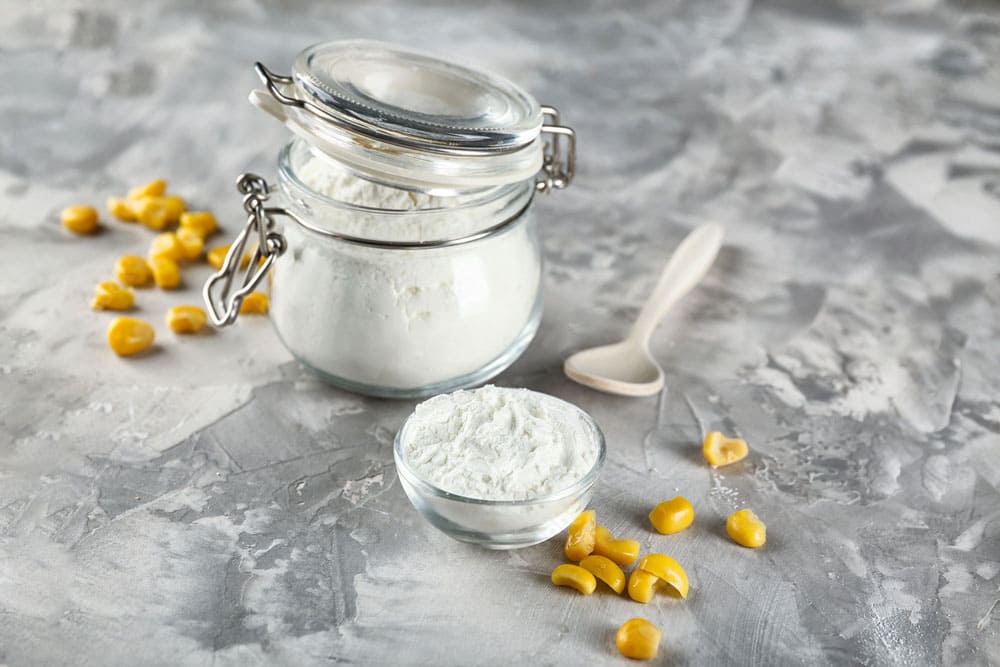
Tips and tricks for making cornstarch
Here are some tips and tricks to help you get the best results:
- Choosing the right corn: The quality of the corn you use will greatly affect the quality of the cornstarch. Choose fresh, organic corn that is free of pesticides and other chemicals. You can also experiment with different types of corn to find the one that produces the best results.
- Adjusting water ratio: The amount of water you add to the corn while grinding can affect the consistency of the cornstarch. Adjust the water ratio to get the desired thickness of the cornstarch. If the cornstarch is too thick, add more water. If it’s too thin, add more cornstarch.
- Using different drying methods: There are various ways to dry cornstarch, including sun-drying, oven-drying, and air-drying. Experiment with different methods to see which one works best for you. If you live in a humid climate, it may be best to use an oven or dehydrator to ensure that the cornstarch is fully dried.
- Maintaining cleanliness and hygiene: It’s important to maintain cleanliness and hygiene throughout the cornstarch making process to ensure that the final product is safe to use. Wash your hands thoroughly before handling the corn and use clean utensils and bowls. Keep the workspace clean and free of any contaminants.
Making cornstarch can be a fun and rewarding experience, and with a little experimentation, you can create your own unique version of this versatile ingredient.
How to make cornstarch from flour?
While it is possible to make cornstarch from corn flour, it’s important to note that the process is quite different from making cornstarch from whole corn kernels. Corn flour is made by grinding the entire corn kernel, while cornstarch is made by extracting only the starch from the kernel.
To make cornstarch from corn flour, you’ll need to follow these steps:
- Mix the corn flour with water in a bowl, stirring until it forms a smooth, runny paste.
- Pour the mixture into a large pot and add more water, using a ratio of 3 parts water to 1 part corn flour.
- Heat the mixture on medium-high heat, stirring constantly, until it comes to a boil.
- Reduce the heat to low and continue stirring for 10-15 minutes, or until the mixture thickens and turns into a paste.
- Remove the pot from the heat and let the mixture cool.
- Once the mixture has cooled, pour it through a fine-mesh strainer to separate the starch from the remaining flour.
- Allow the starch to dry completely by spreading it out on a baking sheet or tray and placing it in the sun or oven at a low temperature.
- Once the starch is completely dry, grind it into a fine powder using a food processor or coffee grinder.
While making cornstarch from flour is possible, the resulting product may not be as pure or effective as cornstarch made from whole corn kernels. It’s best to use whole corn kernels to ensure the highest quality and purity of the cornstarch.
How to store cornstarch?
It is critical to store cornstarch properly to keep it fresh and maintain its quality. Here’s how to keep cornstarch safe:
- Keep it in a cool, dry place: Cornstarch should be stored in a cool, dry place, away from heat and moisture. Store it in an airtight container to prevent moisture from getting in.
- Label the container: It’s a good idea to label the container with the date of production so that you can keep track of how long it’s been stored.
- Use it within 6 months: Cornstarch has a shelf life of around 6 months, so try to use it up within this time frame to ensure its freshness.
- Avoid exposing it to air: Cornstarch can easily absorb moisture and odors from the air, so it’s best to store it in a sealed container. Avoid storing it in an open container or leaving the container open for extended periods of time.
- Don’t store it in the refrigerator or freezer: While refrigeration or freezing can extend the shelf life of some foods, it’s not recommended for cornstarch. Storing it in a cold environment can cause it to clump or lose its texture.
FAQs
What can I use instead of cornstarch?
Arrowroot Powder: Arrowroot powder is a natural thickener that is similar to cornstarch in texture and function. It works well in sauces, soups, and stews.
Potato Starch: Potato starch is another natural thickener that can be used in place of cornstarch. It’s great for thickening gravies, sauces, and pie fillings.
Tapioca Starch: Tapioca starch is made from the cassava root and is often used as a gluten-free thickener in recipes. It’s great for thickening soups, stews, and gravies.
Rice Flour: Rice flour is a gluten-free alternative to wheat flour that can also be used as a thickener. It works well in Asian dishes like stir-fries and soups.
All-Purpose Flour: All-purpose flour can also be used as a thickener in recipes. It’s not gluten-free, so it may not be suitable for those with gluten intolerance or celiac disease. It works well in gravies, sauces, and custards.
How to use flour instead of cornstarch?
If you want to use flour instead of cornstarch as a thickening agent, here’s how:
- Determine the amount of cornstarch called for in your recipe. You’ll need to use twice as much flour as cornstarch to achieve the same thickening power.
- Mix the flour with a small amount of cold water or broth to create a slurry. You want the slurry to be smooth and free of lumps.
- Add the slurry to the dish you’re cooking, stirring constantly. You can add it at the beginning of the cooking process or towards the end.
- Allow the dish to cook for a few minutes, stirring occasionally, until the sauce or soup has thickened to your desired consistency.
Keep in mind that flour has a slightly different texture and taste than cornstarch, so it may not work as well in certain dishes.
For example, flour can make sauces and gravies look cloudy or have a slightly floury taste. It’s best to use flour as a substitute for cornstarch in dishes where the appearance and taste aren’t critical, such as in soups and stews.
If you’re looking for a gluten-free alternative to cornstarch, try using arrowroot powder or potato starch instead of flour.
What is healthier cornstarch or flour?
Cornstarch is made from the endosperm of corn kernels and is primarily a source of carbohydrates. It is low in fat, protein, and fiber. While cornstarch is not particularly nutrient-dense, it is gluten-free and can be a good alternative to wheat flour for those with gluten intolerance or celiac disease.
Flour, on the other hand, can be made from a variety of grains, including wheat, rice, and corn. It is a good source of complex carbohydrates, protein, fiber, vitamins, and minerals. Whole-grain flour, in particular, contains more nutrients than refined flour.
When comparing the two, flour is generally considered to be healthier than cornstarch due to its higher nutrient content. However, the health benefits of flour depend on the type of flour and how it’s processed. Refined white flour, for example, is less nutritious than whole-grain flour.
Cornstarch, corn meal, and corn flour: What’s the difference?
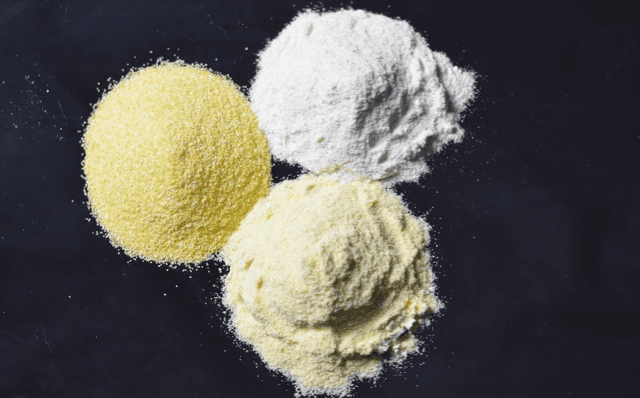
Cornstarch is made from only the starchy part of the corn kernel and is a fine, powdery substance. It is primarily used as a thickener in recipes and is commonly used in sauces, gravies, and soups. Cornstarch is also used as a coating for fried foods to give them a crispy texture.
Corn meal is made from the entire kernel of corn, including the germ, bran, and endosperm. It is ground into a coarse texture and can be used in a variety of recipes, including cornbread, polenta, and porridge. Cornmeal can also be used as a coating for fried foods and is commonly used in Southern-style cooking.
Corn flour is also made from the entire kernel of corn, but it is ground into a fine powder. It is used in a variety of recipes, including bread, pancakes, and tortillas. Corn flour can also be used as a thickener in recipes, but it is not as effective as cornstarch.
Conclusion
Learning how to make cornstarch at home is a fun and rewarding experience that can be done with just a few simple ingredients and some patience. Through my personal experience, I have learned that making cornstarch at home is not only cost-effective but also allows me to control the quality and purity of the final product. By following the step-by-step guide and tips and tricks outlined in this post, anyone can make their own cornstarch that is safe, effective, and versatile for use in a variety of recipes.
While there are many different types of thickeners available, cornstarch remains a popular choice due to its neutral flavor and ability to thicken and stabilize foods. Whether you’re making sauces, gravies, or custards, cornstarch can help you achieve the perfect texture and consistency.
So why not give it a try and make your own cornstarch at home? With a little effort and practice, you’ll be able to create a versatile and useful ingredient that can take your cooking and baking to the next level.

